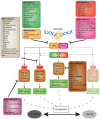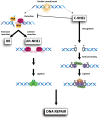DNA Damage Signalling and Repair Inhibitors: The Long-Sought-After Achilles' Heel of Cancer
- PMID: 26610585
- PMCID: PMC4693276
- DOI: 10.3390/biom5043204
DNA Damage Signalling and Repair Inhibitors: The Long-Sought-After Achilles' Heel of Cancer
Abstract
For decades, radiotherapy and chemotherapy were the two only approaches exploiting DNA repair processes to fight against cancer. Nowadays, cancer therapeutics can be a major challenge when it comes to seeking personalized targeted medicine that is both effective and selective to the malignancy. Over the last decade, the discovery of new targeted therapies against DNA damage signalling and repair has offered the possibility of therapeutic improvements in oncology. In this review, we summarize the current knowledge of DNA damage signalling and repair inhibitors, their molecular and cellular effects, and future therapeutic use.
Keywords: ATM; ATR; CHK1; CHK2; DNA repair; MRE11; PARP; RAD51; inhibitors.
Figures




Similar articles
-
Perspective on the pipeline of drugs being developed with modulation of DNA damage as a target.Clin Cancer Res. 2010 Sep 15;16(18):4527-31. doi: 10.1158/1078-0432.CCR-10-0984. Epub 2010 Sep 7. Clin Cancer Res. 2010. PMID: 20823148 Review.
-
Nanotechnology in cancer therapy: targeting the inhibition of key DNA repair pathways.Curr Mol Med. 2010 Oct;10(7):626-39. doi: 10.2174/156652410792630599. Curr Mol Med. 2010. PMID: 20712589 Review.
-
Targeting the DNA Damage Response in Cancer.Mol Cell. 2015 Nov 19;60(4):547-60. doi: 10.1016/j.molcel.2015.10.040. Mol Cell. 2015. PMID: 26590714 Review.
-
DNA damage response inhibitors: Mechanisms and potential applications in cancer therapy.Cancer Treat Rev. 2017 Nov;60:139-151. doi: 10.1016/j.ctrv.2017.08.013. Epub 2017 Sep 19. Cancer Treat Rev. 2017. PMID: 28961555 Review.
-
DNA repair proteins as molecular targets for cancer therapeutics.Anticancer Agents Med Chem. 2008 May;8(4):417-25. doi: 10.2174/187152008784220294. Anticancer Agents Med Chem. 2008. PMID: 18473726 Free PMC article. Review.
Cited by
-
Homologous Recombination Deficiency in Ovarian, Breast, Colorectal, Pancreatic, Non-Small Cell Lung and Prostate Cancers, and the Mechanisms of Resistance to PARP Inhibitors.Front Oncol. 2022 Jun 17;12:880643. doi: 10.3389/fonc.2022.880643. eCollection 2022. Front Oncol. 2022. PMID: 35785170 Free PMC article. Review.
-
Biological effects of radiation on cancer cells.Mil Med Res. 2018 Jun 30;5(1):20. doi: 10.1186/s40779-018-0167-4. Mil Med Res. 2018. PMID: 29958545 Free PMC article. Review.
-
TGFbeta and miRNA regulation in familial and sporadic breast cancer.Oncotarget. 2017 Jan 30;8(31):50715-50723. doi: 10.18632/oncotarget.14899. eCollection 2017 Aug 1. Oncotarget. 2017. PMID: 28881597 Free PMC article.
-
The oncoprotein DEK affects the outcome of PARP1/2 inhibition during mild replication stress.PLoS One. 2019 Aug 13;14(8):e0213130. doi: 10.1371/journal.pone.0213130. eCollection 2019. PLoS One. 2019. PMID: 31408463 Free PMC article.
-
Cancer-causing mutations in the tumor suppressor PALB2 reveal a novel cancer mechanism using a hidden nuclear export signal in the WD40 repeat motif.Nucleic Acids Res. 2017 Mar 17;45(5):2644-2657. doi: 10.1093/nar/gkx011. Nucleic Acids Res. 2017. PMID: 28158555 Free PMC article.
References
Publication types
MeSH terms
Substances
Grants and funding
LinkOut - more resources
Full Text Sources
Other Literature Sources
Research Materials
Miscellaneous

